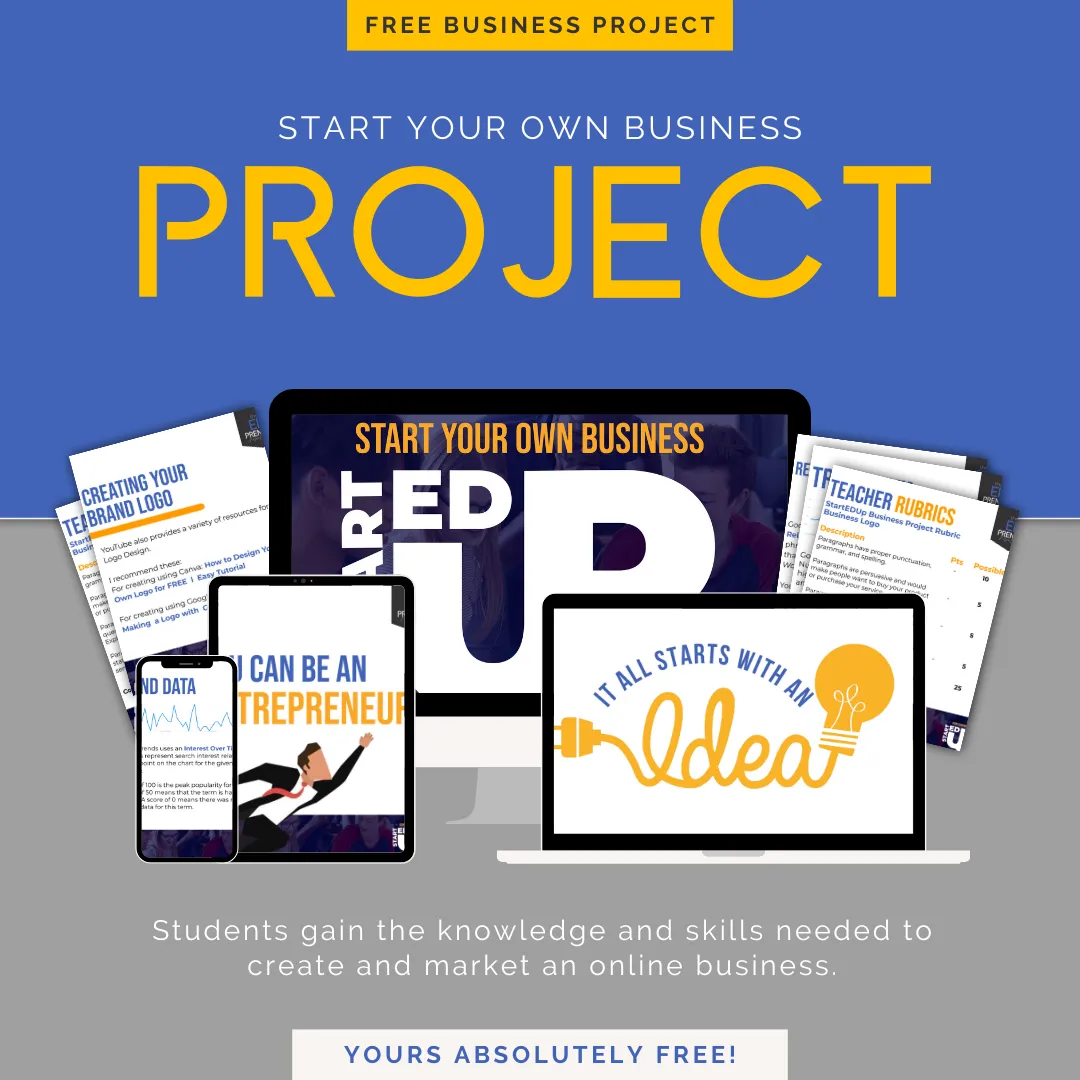
Entrepreneurship is a powerful tool teachers can use to cultivate a passion for learning and ignite creativity in their classroom.

Transform Learning in Your Classroom By Introducing Students to Entrepreneurship
“Introducing entrepreneurial thinking in your classroom can transform the way students learn by helping them see the greater vision behind the problems they're working to solve.” - Ryan Owens
Transform How Students Learn in Your Classroom by Introducing them to Entrepreneurship
Why Entrepreneurship in the Classroom?

Infusing entrepreneurial thinking in your classroom can transform the way your students learn and help them develop real-world skills that are essential for success in our rapidly changing world.
Entrepreneurship can teach students crucial life skills including:
Collaboration
Communication
Critical Thinking
How to use social media as an advocacy tool
Curiosity
Creativity
The Internet has transformed the way we collect and consume information, providing unlimited resources to learn and acquire new skills.This access has made it a lot easier for everyone to pursue a career in entrepreneurship. As teachers, we want to expose our students to the endless opportunities for learning and practicing new skills. In today’s connected society, there is an unprecedented rise in services that can be used to earn an income. As a result, students need to be prepared for entering an entrepreneurial society.
Here are five simple ways you can cultivate an entrepreneurial mindset in your classroom...
1. Inspire Creativity and Critical Thinking through Creative Questioning:

In his New York Times best-seller, The One Thing, Gary Keller inspires his readers to ask better questions by reminding us, “Life is a question and how we live it is our answer”. How can we apply this principle in our own classrooms and incorporate activities into our instruction that will cultivate thinking outside the box?
Start simply by restructuring your questions. For example, in a lesson centered around digital technology, you can incorporate a question to the effect of “How could you change this technology to make it better?” Our students are incredibly imaginative and have not yet been exposed to perceived limits on what is and isn’t possible.
Using Creative Questioning, a simple activity can easily be transformed into an opportunity to evoke critical thinking and creativity. One of my favorite creative questioning activities is the game Disruptus.
Disruptus cultivates disruptive thinking by asking players to look at an object, a process, or an idea and come up with an entirely different way to achieve its purpose or visualize a new purpose altogether.
Players come up with ideas that may Create, Transform, Improve, or Disrupt.
2. Create Curiosity through Book Talks

One of the simplest and effective ways to cultivate an entrepreneurial mindset in your classroom is to model Book Talks for your students. Perform a class read aloud or introduce books that speak to entrepreneurship and include them in your lessons.
There are many great resources written for younger audiences interested in entrepreneurship. Select books that are suitable and put together a class library dedicated to the topic. In place of a boring book report, consider assigning a simple Book Talk on an entrepreneurial book of their choosing.
How students communicate their review is up to you and can be easily modified to meet your students’ needs and abilities. This simple task will open students' minds to see the possibilities of entrepreneurship.
Here are a few of my favorites:
The Young Entrepreneurs Guide to Starting a Business
3. Host a Virtual Ted Talk Day

Host a Ted Talk Day for your students and invite (virtually speaking, of course) entrepreneurs from different industries as speakers. Like us, a narrative has been created that our students should grow up to be doctors, lawyers, police officers, teachers and firefighters. These traditional career paths are what students most often grow to want to emulate because children live what they see.
This is a simple and effective opportunity to give them another perspective. Set the stage and build anticipation by creating your own personal introduction for the chosen speaker or turn your classroom into an auditorium.
There are so many simple things you can prepare to build students’ excitement and engagement for the experience.
My TedEd Recommendations:
Why Now is The Time to be a Youth Entrepreneur
Let’s Raise Kids to Be Entrepreneurs
Why We Need More Young Entrepreneurs
4. Teach Your Students How to Sell
“Sell” is not the bad, four-letter word so many of us have grown up believing it to be. “Selling” is something we all do and in fact, is an essential skill. Teaching your students how to sell is simpler than you think and you’ve probably been doing it for years. Remember those creative writing activities you’ve assigned in the past? How hard you and your students worked to use descriptive words to evoke feeling and imagination in their writing? Or, those persuasive writing pieces where you helped students justify their attitudes or beliefs evolved around a topic?

The truth is, you have already provided students with skills and experiences that have prepared them to sell to the marketplace. Give them opportunities to put those skills into action through their communication. This is also called copy writing.
Examples:
An elementary student may sell a piece of chocolate to another student by using descriptive writing to describe how sweet the chocolate will taste in their mouth or the happy feeling they will experience when it melts in their mouth, or by reminding the other student how hungry they are.
A middle schooler may write to persuade another student to buy their “product” by listing and describing reasons why it will change their life, make life easier, solve their problem or make them happier.Students can practice verbally communicating as well through a speech or presentation.
5. Failure is Only Feedback
Teach your students how to see the lessons in their failures. This creates a perspective shift where they become solution oriented. It’s human nature to want to dwell on failures and children are no different.
However, as adults we know we have the choice to process failure differently because we have had enough experiences to understand that we need to learn from them. But how long did it take us to shift to this perspective? Teach your students to shift their perspective from an early stage.

Use The A.I.M. Principle...
“Learning from failure can help students increase their determination to succeed.”
Allow: Cultivate a positive learning environment in which students are allowed and comfortable with making mistakes and where the word failure purely means feedback.
Investigate: In addition to pointing out the mistake, help students investigate the “why and how” as well as “what to learn from them.”
Motivate: Motivation occurs through encouraging students to meet their failures head on and brainstorm solutions. With every mistake they overcome, students build internal motivation and confidence to undertake more complex tasks.
Helping teachers get students engaged and cultivate creativity through entrepreneurial experiences has become one of my passions. My goal is to help both teachers and students discover their own entrepreneurial journey through learning activities centered around problem solving and product creation.

About Ryan...
Ryan and his wife, Ashley, are both full time educators. Ryan is an entrepreneur at heart and currently manages multiple online businesses. His experiences in online business grew into a passion for helping other teachers introduce their students to the power entrepreneurial thinking in their own classrooms.
Ryan created The EDpreneur curriculum of resources to help teachers ignite a spark in their classrooms and activate a new passion for learning through problem solving and an entrepreneurial mindset.

I'D LIKE TO SEND YOU A FREE LESSON!
Just tell me where to send it...
Are you a TpT Teacher Seller?

